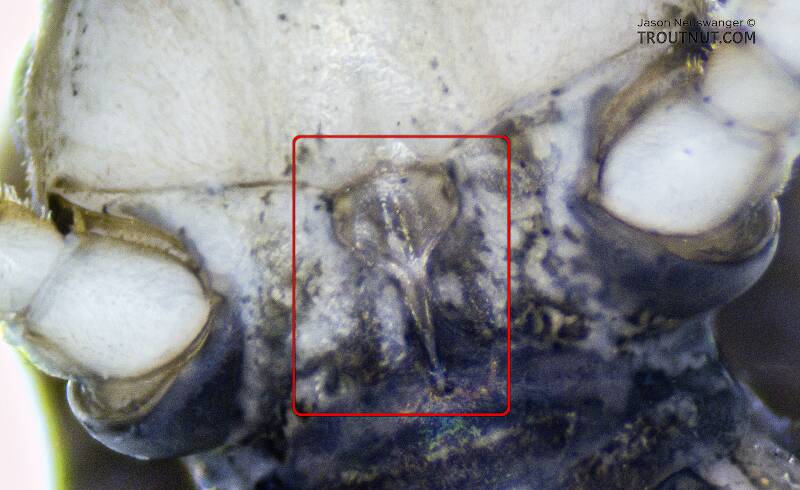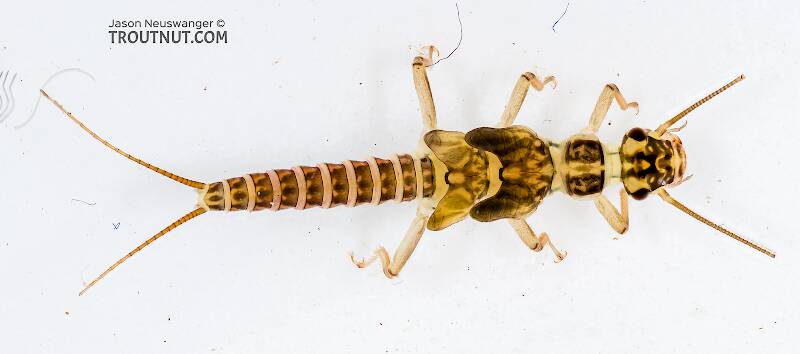
Salmonflies
Pteronarcys californica
The giant Salmonflies of the Western mountains are legendary for their proclivity to elicit consistent dry-fly action and ferocious strikes.
Featured on the forum

Some characteristics from the microscope images for the tentative species id: The postero-lateral projections are found only on segment 9, not segment 8. Based on the key in Jacobus et al. (2014), it appears to key to Neoleptophlebia adoptiva or Neoleptophlebia heteronea, same as this specimen with pretty different abdominal markings. However, distinguishing between those calls for comparing the lengths of the second and third segment of the labial palp, and this one (like the other one) only seems to have two segments. So I'm stuck on them both. It's likely that the fact that they're immature nymphs stymies identification in some important way.

Troutnut is a project started in 2003 by salmonid ecologist Jason "Troutnut" Neuswanger to help anglers and
fly tyers unabashedly embrace the entomological side of the sport. Learn more about Troutnut or
support the project for an enhanced experience here.
Identification: Key to Genera of Perlodidae Nymphs, Couplet 36
Identification: Key to Genera of Perlodidae Nymphs, Couplet 36
Error: Tried to access a key that isn't live.
Adapted from Merritt R.W., Cummins, K.W., and Berg, M.B. (2019)
This couplet refers figures (usually designated 'sf') from this source.
You will need the source (make sure to get the same edition!) to see them.
This couplet refers figures (usually designated 'sf') from this source.
You will need the source (make sure to get the same edition!) to see them.
| Option 1 | Option 2 |
|---|---|
Mesosternal Y-arms with basal stem and fork 
| Mesosternal Y-arms without stem and fork (sf 16.175) |
| Widely distributed | Eastern North America |
1 Example Specimen
This specimen keys pretty well to Cultus. Key characteristics observed under the microscope but not necessarily apparent on my photo are the lack of submental gills (or any gills at all), the lack of short, stout setae on the occiput or anterolateral prothoracic margins, and the lack of a low knob below the subapical tooth on the lacinia. Species known to be found in Washington are Cultus pilatus and Cultus tostonus. It clearly does not fit the description by Frison (1942) of Diploperla pilata, as Cultus pilatus was first named. I cannot find a detailed description of the nymph of tostonus, but Ricker 1952 describes a defining character of the adults, "Head mostly yellow, the only important dark marking being the bands which join the anterior to the lateral ocelli ; median pronotal stripe, at its middle, about one-fifth of the width of the pronotum." The nymph shows a very dark pattern fitting that description on the head (likely retained into adulthood) and the pronotal stripe is about the right width, too. Given that visual description, the range, and the poor fit to pilatus, I'm calling this Cultus tostonus.
| |
| Cultus | Diploperla No further information about this genus is available on Troutnut.com at this time. |
Adapted from Merritt R.W., Cummins, K.W., and Berg, M.B. (2019)
The current couplet is highlighted with darker colors and a icon, and couplets leading to this point have a icon.
Leads to Couplet 2:
- Gills present on one or more thoracic segments (sf 16.145)
Couplet 2
Leads to Couplet 6:
- Gills absent from thoracic segments
Couplet 6
Leads to Oroperla
(Oroperla barbara):
(Oroperla barbara):
- Lateral abdominal gills present (sf 16.146)
- California and Nevada
Leads to Couplet 4:
- Lateral obdominal gills absent
Couplet 4
Leads to Perlinodes
(Perlinodes aurea):
(Perlinodes aurea):
- Cervical gills present (sf 16.145)
- Western North America
Leads to Couplet 5:
- Cervical gills absent
Couplet 5
Leads to Salmoperla
(Salmoperla sylvanica):
(Salmoperla sylvanica):
- Prothoracic gills reduced to nipple-like stubs
- Mesothoracic and metathoracic gills forked (sf 16.35)
- California and Oregon
Leads to Couplet 7:
- Lacinia unidentate, except bidentate in early instar Kogotus
Couplet 7
Leads to Couplet 10:
- Lacinia bidentate
Couplet 10
Leads to Kogotus:
- Mesosternum without transverse anterior furrow
- Western North America
- common
Leads to Rickera
(Rickera sorpta):
(Rickera sorpta):
- Mesosternal furcal pits often connected by a transverse anterior furrow, sometimes difficult to discern in young nymphs (sf 16.151)
- California, Oregon, Washington, Nevada
- rare
Rickera
(Rickera sorpta)
(Rickera sorpta)
Leads to Couplet 11:
- Abdomen with longitudinal pigment bands
Couplet 11
Leads to Couplet 19:
- Abdomen usually without longitudinal pigment bands, having various lateral pigment bands, spots, or various other patterns instead However, at least some Skwala may have a longitudinal dorsal stripe on the abdomen
Couplet 19
Leads to Couplet 12:
- Abdomen with pale, median, longitudinal pigment band
Couplet 12
Leads to Couplet 14:
- Abdomen with dark, median, longitudinal pigment band (may be a dark stripe embedded within a light band)
Couplet 14
Leads to Osobenus
(Osobenus yakimae):
(Osobenus yakimae):
- Apical lacinial tooth about as long as rest of lacinia (sf 16.152)
- Mesosternal Y-arms with secondary furrows extending to anterior corners of furcal pits (sf 16.153)
- British Columbia, California, Oregon, Washington
Leads to Couplet 13:
- Apical lacinial tooth much shorter than rest of lacinia (sf 16.154)
- Mesosternal Y-arms lacking secondary furrows extending to anterior corners of furcal pits
Couplet 13
Leads to Isoperla:
- Inner lacinial margin with row of at least 4-5 long setae
- No prominent knob bearing pegs below subapical lacinial tooth (sf 16.155)
- Widely distributed
Leads to Susulus:
- Inner lacinial margin lacking a row of long setae
- Prominent knob below subapical lacinial tooth bearing 3-4 stout peg-like setae (which may appear as a 3rd tooth under low-power magnification) (sf 16.154)
- California
Susulus
Leads to Couplet 15:
- Lacinia quadrate (sf 16.156)
Couplet 15
Leads to Couplet 18:
- Lacinia triangular or subquadrate
Couplet 18
Leads to Couplet 16:
- Lacinia with a dense brush of stout setae (sf 16.156)
- Inner lacinial margin glabrous
Couplet 16
Leads to Couplet 17:
- Lacinia with one or more rows of stout setae (sf 16.155 and 16.157)
- Inner lacinial margin setose
Couplet 17
Leads to Cascadoperla
(Cascadoperla trictura):
(Cascadoperla trictura):
- Apical cercal segments fringed with fine hairs dorsally and ventrally (sf 16.158)
- Western North America
Cascadoperla
(Cascadoperla trictura)
(Cascadoperla trictura)
Leads to Calliperla
(Calliperla luctuosa):
(Calliperla luctuosa):
- Cerci without marginal fringe
- Mesosternal Y-arms enclosing an area of abundant clothing hairs (sf 16.159)
- California, Oregon, Washington
Calliperla
(Calliperla luctuosa)
(Calliperla luctuosa)
Leads to Cosumnoperla:
- Mesosternal Y-arms sinuate (sf 16.161)
- Cerci lacking fine setal fringe
- California
Cosumnoperla
Leads to Couplet 20:
- Mesosternal Y-arms meet or approach anterior corners of furcal pits
- Mandibles deeply cleft, separating teeth into two major cusps
Couplet 20
Leads to Couplet 22:
- Mesosternal Y-arms meet or approach posterior corners of furcal pits
- Mandibles not deeply cleft
Couplet 22
Leads to Frisonia
(Frisonia picticeps):
(Frisonia picticeps):
- Apical lacinial tooth short, much less than 1/3 the outer lacinial length
- Ventral submarginal lacinial setae extending well onto apical tooth as a closely set row (sf 16.164)
- British Columbia, California, Nevada, Oregon, Washington
Frisonia
(Frisonia picticeps)
(Frisonia picticeps)
Leads to Couplet 21:
- Apical lacinial tooth long, greater than 1/3 the outer lacinial length
- Ventral submarginal lacinial setae end at inner base of apical tooth
Couplet 21
Leads to Skwala:
- Outermost cusp of both mandibles serrate
- Mesal tufts of silky setae on occiput
- Abdominal segments 1–2 divided by pleural fold
- Western North America (the range maps below are off, because they also include compacta)
Leads to Skwala
(Skwala compacta):
(Skwala compacta):
- Outermost cusp of both mandibles unserrated, or with indistinct serrations on left mandible only
- Occiput without mesal tuft of silky setae
- Abdominal segments 1–3 divided by pleural fold
- Western North America and higher latitudes of Eastern North America
Leads to Oconoperla:
- Femora and tibiae without long setal fringe
- Posterolateral margins of pronotum notched
- Southern Appalachians
- Rare
Oconoperla
Leads to Couplet 23:
- Femora or tibiae or both with long setal fringe
- Posterolateral margins of pronotum smoothly rounded
- Widespread
- Some genera common
Couplet 23
Leads to Isogenoides:
- Mesosternum with median longitudinal suture connecting fork of mesosternal Y-arms with transverse suture (sf 16.166)
- Widely distributed
Leads to Couplet 24:
- Mesosternum without median longitudinal suture
Couplet 24
Leads to Couplet 25:
- Submental gills conspicuous, projecting portion usually 2 times or more as long as basal diameter (sf 16.37)
Couplet 25
Leads to Couplet 28:
- Submental gills absent or barely projecting beyond submentum
Couplet 28
Leads to Pictetiella:
- Apical lacinial tooth about half the total outer lacinial length
- Western North America
- Uncommon
Leads to Couplet 26:
- Apical lacinial tooth about 1/3 or less the total outer lacinial length (sf 16.149)
- Eastern North America
- Usually common
Couplet 26
Leads to Malirekus:
- Ventral lacinial surface with a basal patch of about 50 dark clothing hairs (sf 16.149)
Malirekus
Leads to Couplet 27:
- Ventral lacinial surface without dark clothing hairs, a patch of about 10 setae may be present (sf 16.167)
Couplet 27
Leads to Hydroperla:
- Transverse dark pigment band of frons lateral to median ocellus interrupted by circular yellow areas (sf 16.168)
- Ventral lacinial surface with outer patch of about 10 setae (sf 16.169)
- Right mandible with 4 teeth
Leads to Couplet 29:
- Inner lacinial margin with a low knob below subapical tooth (sf 16.149)
Couplet 29
Leads to Couplet 31:
- Inner lacinial margin without a low knob below subapical tooth (sf 16.155)
Couplet 31
Leads to Malirekus:
- Outer ventral lacinial surface with basal patch of about 50 dark clothing hairs (sf 16.149)
- Eastern North America
Malirekus
Leads to Couplet 30:
- Outer ventral lacinial surface with fewer than 50 basal clothing hairs (sf 16.167)
Couplet 30
Leads to Yugus:
- Marginal lacinial setal row extending from near subapical tooth to near base (sf 16.167)
- Labrum with yellow longitudinal mesal band
- Submental gills very short, if present
- Eastern North America
Yugus
Leads to Couplet 32:
- Occiput or anterolateral prothoracic margins or both with a row of short stout setae
Couplet 32
Leads to Couplet 36:
- Occiput and anterolateral prothoracic margins without rows of short, stout setae (a few long setae may be present)
Couplet 36
Leads to Clioperla
(Clioperla clio):
(Clioperla clio):
- Ocellar region transversed by dark band connecting lateral ocelli and eyes but not covering anterior ocellus (sf 16.38); a dark form lacking the light medial area of head, with light M-line
- Abdominal terga with pale media, paired spots
- Eastern North America
Leads to Couplet 33:
- Ocellar triangle more or less covered by dark pigment
- Abdominal terga with 3 pairs pale or dark spot, or lacking such spots
Couplet 33
Leads to Baumannella
(Baumannella alameda):
(Baumannella alameda):
- Outer mandibular cusp serrate
- Abdominal terga with anterior narrow dark mesal bands and conspicuous transverse row of dark spots
- California
Baumannella
(Baumannella alameda)
(Baumannella alameda)
Leads to Couplet 34:
- Major mandibular cusp without serrations
- Abdominal terga with variable color pattern
Couplet 34
Leads to Chernokrilus:
- Mesosternal Y-arms with indistinct anterior extensions which approach furcal pits (sf 16.172)
- California, Oregon
Chernokrilus
Leads to Couplet 35:
- Mesosternal Y-arms without anterior extensions
- Widely distributed
Couplet 35
Leads to Diura:
- Occipital area with a pair of pale oval markings adjacent to compound eyes; posterior margins of ovals marked by dense irregular rows of short, thick setae (sf 16.173)
- Western North America and higher latitudes of Eastern North America
Couplet 36 (You are here)
Leads to Diploperla:
- Mesosternal Y-arms without stem and fork (sf 16.175)
- Eastern North America
Diploperla
Start a Discussion of this Couplet
References
- Jacobus, L. M., Wiersema, N.A., and Webb, J.M. 2014. Identification of Far Northern and Western North American Mayfly Larvae (Insecta: Ephemeroptera), North of Mexico; Version 2. Joint Aquatic Science meeting, Portland, OR. Unpublished workshop manual. 1-176.
- Merritt R.W., Cummins, K.W., and Berg, M.B. 2019. An Introduction to the Aquatic Insects of North America (Fifth Edition). Kendall/Hunt Publishing Company.

